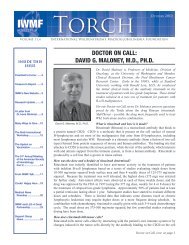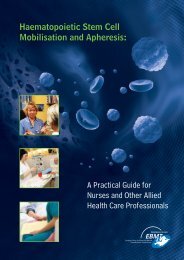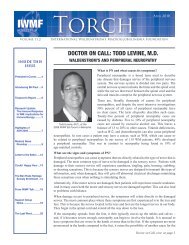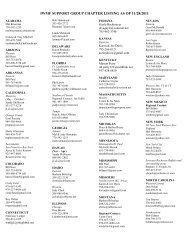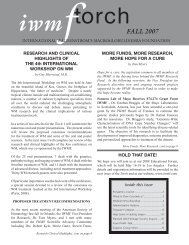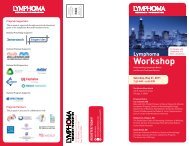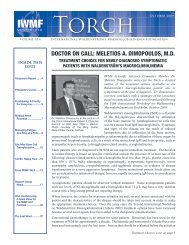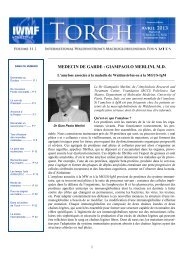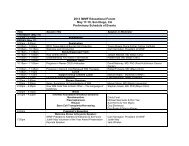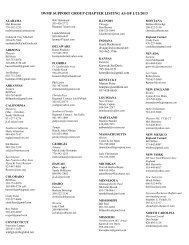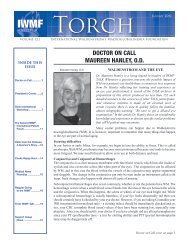English - International Waldenstrom's Macroglobulinemia Foundation
English - International Waldenstrom's Macroglobulinemia Foundation
English - International Waldenstrom's Macroglobulinemia Foundation
Create successful ePaper yourself
Turn your PDF publications into a flip-book with our unique Google optimized e-Paper software.
OFFICERS &<br />
TRUSTEES<br />
FOUNDER<br />
Arnold Smokler<br />
PRESIDENT EMERITA<br />
Judith May<br />
PRESIDENT<br />
Carl Harrington<br />
SECRETARY-TREASURER<br />
Cynthia Ruhl<br />
VICE PRESIDENTS<br />
Tom Myers, Jr.<br />
Marty Glassman<br />
BOARD OF TRUSTEES<br />
L. Don Brown<br />
Peter DeNardis<br />
Sue Herms<br />
Marcia Klepac<br />
Robert A. Kyle, M.D.<br />
Elena Malunis<br />
Michael Sesnowitz<br />
Guy Sherwood, M.D.<br />
Ronald Yee<br />
BUSINESS OFFICE<br />
Sara McKinnie, Office Manager<br />
IWMF SCIENTIFIC<br />
ADVISORY COMMITTEE<br />
Robert A. Kyle, M.D., Director<br />
Mayo Clinic<br />
Stephen Ansell, M.D.<br />
Mayo Clinic<br />
Bart Barlogie, M.D.<br />
University of Arkansas<br />
James R. Berenson, M.D.<br />
Institute for Myeloma &<br />
Bone Cancer Research<br />
Morton Coleman, M.D.<br />
Weill Cornell Medical College<br />
Meletios A. Dimopoulos, M.D.<br />
School of Medicine,<br />
University of Athens, Greece<br />
Stanley Frankel, M.D.<br />
Columbia University<br />
Morie Gertz, M.D.<br />
Mayo Clinic<br />
Irene Ghobrial, M.D.<br />
Dana-Farber Cancer Institute<br />
Eva Kimby, M.D.<br />
Karolinska Institute, Sweden<br />
Véronique Leblond. M.D.<br />
Hôpital Pitié Salpêtrière, France<br />
Gwen Nichols, M.D.<br />
Hoffmann-La Roche, Ltd.<br />
Steven Treon, M.D.<br />
Dana-Farber Cancer Institute<br />
Mary Varterasian, M.D.<br />
Donna Weber, M.D.<br />
M.D. Anderson Cancer Center<br />
Doctor on Call cont. from page 1<br />
this is an uncommon event, and in fact IgM-associated amyloidosis represents only 5 to 6%<br />
of all cases of AL amyloidosis, with a yearly expected incidence of 0.6 cases per million.<br />
On the other hand, when an IgM-associated amyloidosis arises, it may become necessary<br />
to modify the treatment and monitoring of the underlying disease. Therefore the possibility<br />
of developing an IgM-associated amyloidosis should always be taken into account when<br />
monitoring patients with Waldenström macroglobulinemia or IgM-MGUS.<br />
The IgM-associated amyloidosis presents distinct features when compared to non-IgM<br />
associated amyloidosis: 1) the concentration of the circulating free light chains is lower,<br />
2) the heart is less frequently and less severely involved, and 3) the amyloid is frequently<br />
localized in the lung and in lymph nodes.<br />
When should one suspect the presence of amyloidosis?<br />
Primary amyloidosis can target practically all organs, except the brain. The kidney is<br />
involved in two-thirds of amyloidosis patients, characterized by loss of proteins in the urine,<br />
which becomes foamy, by swelling of the legs, and by eventual damage to the purifying<br />
function of the kidney. The heart is involved in almost half of the patients who develop<br />
shortness of breath during their usual activities, difficulties in climbing the stairs, fatigue,<br />
low blood pressure, and swelling of the legs. The nerves are affected in more than one<br />
quarter of patients, with tingling, numbness, burning, loss of sensitivity to hot or cold at<br />
the feet and legs, and, as the neuropathy progresses up to the knee, it may extend to the<br />
arms starting from the fingers. The amyloid can also damage the autonomic nervous system<br />
that regulates certain functions, such as bowel movements and erectile function in men,<br />
resulting in diarrhea or constipation and impotence. The lung and the upper respiratory<br />
passages can be involved by amyloid deposits with possible obstruction of the airways and<br />
reduced blood oxygenation contributing to shortness of breath. In one-fifth of patients, the<br />
lymph nodes can slowly become enlarged because of the amyloid deposition. The tongue<br />
can also become enlarged and stiff and show tooth impressions. Amyloid deposits in the<br />
liver can cause enlargement of the liver with possible compression of the stomach and loss<br />
of appetite. In a few patients, the amyloid deposits in the blood vessels make them fragile<br />
with easy bruising and purple spots that vanish in a few days, particularly around the eyes<br />
and at the base of the neck.<br />
As described, the clinical manifestations are very diverse and can mimic common<br />
conditions in the elderly, such has cardiac failure or kidney and nerve dysfunction in<br />
patients with diabetes, making amyloidosis a difficult entity to be recognized. This holds<br />
especially true for amyloidosis associated with Waldenström macroglobulinemia, since<br />
PRESIDENT<br />
Carl Harrington<br />
EDITOR<br />
Alice Riginos<br />
ASSOCIATE EDITOR<br />
Sue Herms<br />
SENIOR WRITER<br />
Guy Sherwood<br />
The IWMF Torch is a publication of:<br />
<strong>International</strong> Waldenstrom’s <strong>Macroglobulinemia</strong> <strong>Foundation</strong><br />
6144 Clark Center Avenue • Sarasota, FL 34238<br />
Telephone 941-927-4963 • Fax 941-927-4467<br />
E-mail: info@iwmf.com • Website: www.iwmf.com<br />
This publication is designed to provide information about the disease Waldenstrom’s macroglobulinemia.<br />
It is distributed as a member service by the <strong>International</strong> Waldenstrom’s <strong>Macroglobulinemia</strong> <strong>Foundation</strong>,<br />
Inc., to those who seek information on Waldenstrom’s macroglobulinemia with the understanding that the<br />
<strong>Foundation</strong> is not engaged in rendering medical advice or other professional medical services.<br />
INTERNATIONAL CORRESPONDENT<br />
Annette Aburdene<br />
SUPPORT GROUP NEWS<br />
Penni Wisner<br />
CULINARY EDITOR<br />
Penni Wisner<br />
FORMATTING & PRODUCTION<br />
Sara McKinnie<br />
Doctor on Call cont. on page 3<br />
IWMF is a 501(c)(3) tax exempt non-profit organization Fed ID #54-1784426. <strong>Waldenstrom's</strong> macroglobulinemia<br />
is coded 273.3 in the <strong>International</strong> Classification of Diseases (ICD) of the World Health Organization.



